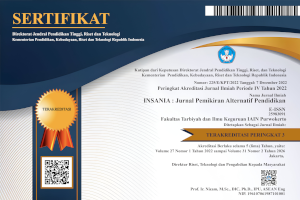Pembentukan Karakter Anak Melalui Kesenian Tradisional Srandul : Kajian Semiotika Roland Barthes
DOI:
https://doi.org/10.24090/insania.v20i1.1425Abstract
Abstract: Traditional art’ Srandul in Cental Java and Yogyakarta have fluctuation along whit the development of other arts. Observing Srandul condition today at least we faced with two things; Frist, the existence of this traditional art began to fade. Second,this traditional art contains values of good character. The second part is a treasure of traditional arts that should be distributed to the present generation, especially children, who almost lost his identity. There are some thing behind the above problems, among others; lact of training and the preservation of Srandul for children, a lact of by society understanding about history and the economic value of Srandul. The purpose of this study was to save the Srandul traditional art and spread the values of the characters in the generation of children, and more importantly to do with vision, mission, Semarang State University as the University of Conservation is a bridge between the university and the public. Keywords: traditional, identity, culture, and character.Downloads
Downloads
Published
How to Cite
Issue
Section
License
Authors who publish with this journal agree to the following terms:
Authors retain copyright and grant the journal right of first publication with the work simultaneously licensed under a Creative CommonsAttribution-ShareAlike License that allows others to share the work with an acknowledgment of the work's authorship and initial publication in this journal.
Authors are able to enter into separate, additional contractual arrangements for the non-exclusive distribution of the journal's published version of the work (e.g., post it to an institutional repository or publish it in a book), with an acknowledgment of its initial publication in this journal.
Authors are permitted and encouraged to post their work online (e.g., in institutional repositories or on their website) prior to and during the submission process, as it can lead to productive exchanges, as well as earlier and greater citation of published work (See The Effect of Open Access).








